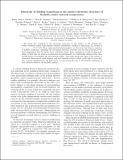Hierarchy of Lifshitz transitions in the surface electronic structure of Sr2RuO4 under uniaxial compression
View/
Date
03/03/2023Author
Grant ID
EP/T02108X/1
EP/R031924/1
714193
2016-006
Metadata
Show full item recordAbstract
We report the evolution of the electronic structure at the surface of the layered perovskite Sr2RuO4 under large in-plane uniaxial compression, leading to anisotropic B1g strains of εxx − εyy = −0.9 ± 0.1%. From angle-resolved photoemission, we show how this drives a sequence of Lifshitz transitions, reshaping the low-energy electronic structure and the rich spectrum of van Hove singularities that the surface layer of Sr2RuO4 hosts. From comparison to tight-binding modelling, we find that the strain is accommodated predominantly by bond-length changes rather than modifications of octahedral tilt and rotation angles. Our study sheds new light on the nature of structural distortions at oxide surfaces, and how targeted control of these can be used to tune density of states singularities to the Fermi level, in turn paving the way to the possible realisation of rich collective states at the Sr2RuO4 surface.
Citation
Abarca Morales , E , Siemann , G-R , Zivanovic , A , Murgatroyd , P , Markovic , I , Edwards , B , Hooley , C , Sokolov , D , Kikugawa , N , Cacho , C , Watson , M , Kim , T , Hicks , C W , Mackenzie , A & King , P 2023 , ' Hierarchy of Lifshitz transitions in the surface electronic structure of Sr 2 RuO 4 under uniaxial compression ' , Physical Review Letters , vol. 130 , no. 9 , 096401 . https://doi.org/10.1103/PhysRevLett.130.096401
Publication
Physical Review Letters
Status
Peer reviewed
ISSN
0031-9007Type
Journal article
Description
Funding: We gratefully acknowledge support from the Engineering and Physical Sciences Research Council (Grant Nos. EP/T02108X/1 and EP/R031924/1), the European Research Council (through the QUESTDO project, 714193), and the Leverhulme Trust (Grant No. RL-2016-006). E.A.M., A.Z., and I.M. gratefully acknowledge studentship support from the International Max-Planck Research School for Chemistry and Physics of Quantum Materials. N.K. is supported by a KAKENHI Grants-in-Aids for Scientific Research (Grant Nos.18K04715, and 21H01033), and Core-to-Core Program (No. JPJSCCA20170002) from the Japan Society for the Promotion of Science (JSPS) and by a JST-Mirai Program (Grant No. JPMJMI18A3). APM and CWH acknowledge support from the Deutsche Forschungsgemeinschaft - TRR 435 288 - 422213477 (project A10). We thank Diamond Light Source for access to Beamline I05 (Proposals SI27471 and SI28412), which contributed to the results presented here.Collections
Items in the St Andrews Research Repository are protected by copyright, with all rights reserved, unless otherwise indicated.

